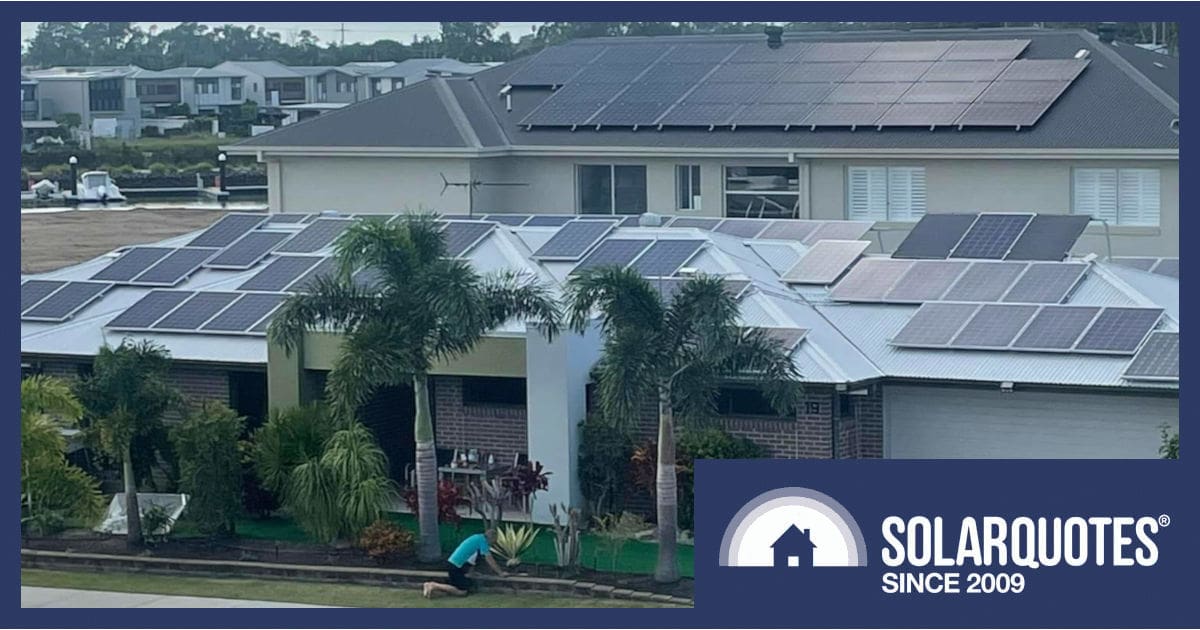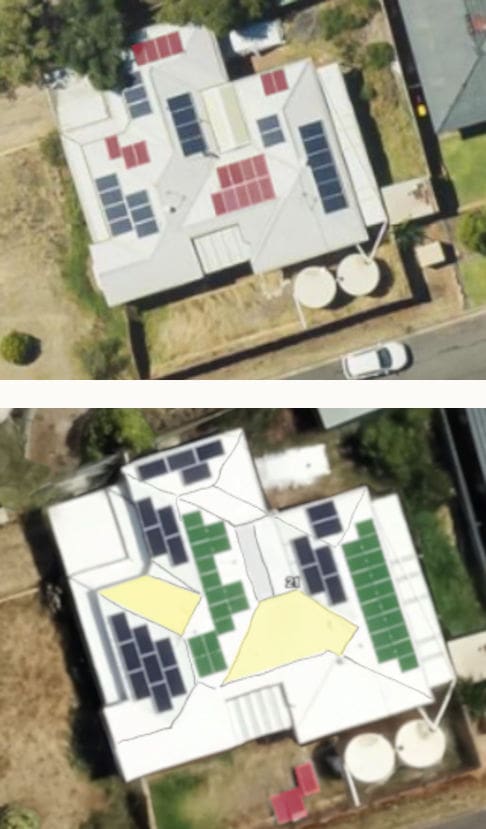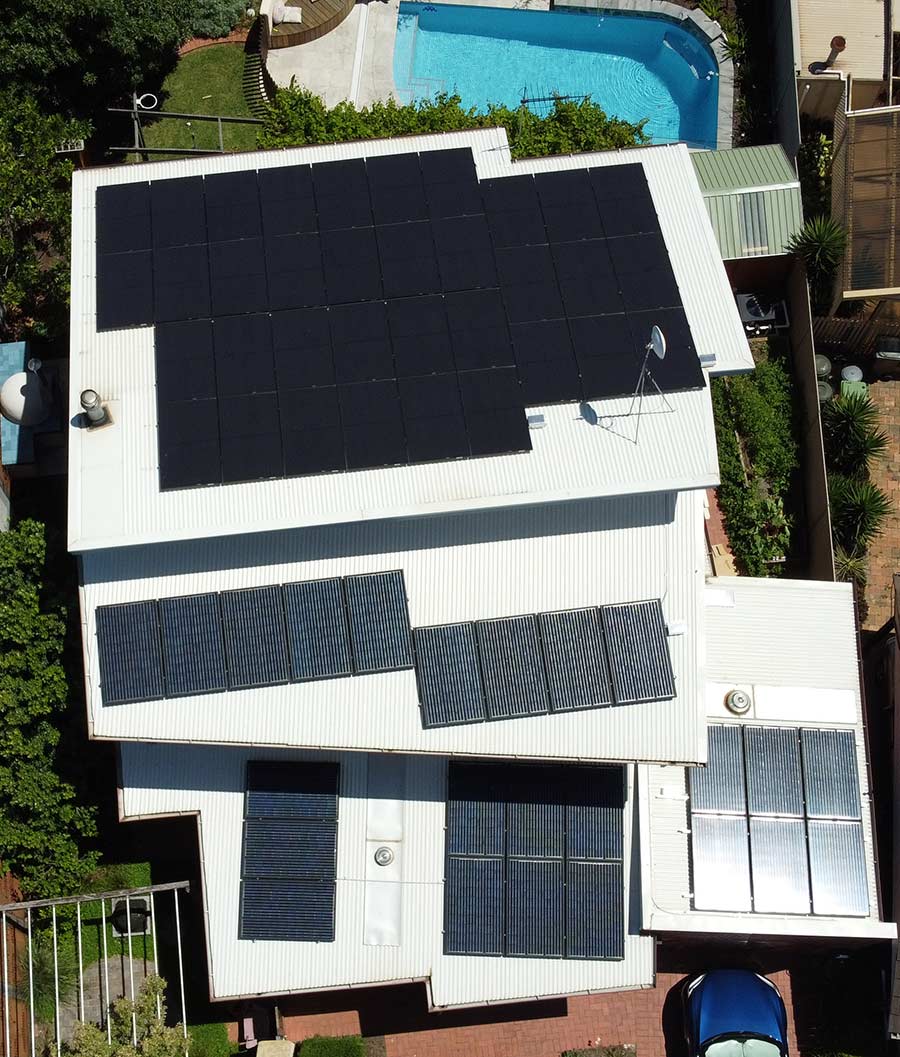
image credit: Kelvin Graves – Crap Solar Facebook group
I’ve recently noticed an uptick in questions from previously satisfied solar owners. With rising prices eroding their savings, they’re looking to boost their solar yield. If you’d like more solar, read on and we’ll explain how to go about it.
Whether you’re an energy enthusiast or just looking to lower your bill, this article is the first in a series on how to enhance your existing solar setup. There’s a few traps and complexities depending on where you’re starting from. We’ll outline the different approaches needed here and detail more in coming episodes.
There’s a lot of questions; and one place to start.
Solar owners have made one consistent complaint to me over the last 15+ years; they wish they’d installed more.
Step 1: Assess Your Current System
If you have a premium feed in tariff then the daytime electricty you generate will be earning about 10 times more than it’s worth. As these schemes expire in Victoria soon and SA/QLD in 2028 customers will get a reality check on their power bill.
For these customers I would suggest a switchboard upgrade and monitoring like CatchControl to analyse what you really need before the tariff ends. The hardware can then become part of your new solar when the time comes.
New systems come with a new warranty, monitoring, and higher efficiency. Eliminating fire-prone rooftop isolators also makes them a no-brainer.
Even A Newish System Isn’t Safe From The Latest Rules
Australian Standards governing solar inverters, solar panels, and batteries have been revised numerous times in the industry’s relatively short life so far.
Many systems won’t meet current rules for power quality or the dynamic controls which network companies (DNSPs) increasingly require.1 Even a 2020 complaint inverter is not grandfathered, so when customers want to add more solar, sadly this means a lot of good gear will go in the bin.
Step 2: Make A Plan
It still pays to work out where your energy is going. If you have solar monitoring or a utility smart meter, then access the data. Even if you can make head nor tail of the raw numbers, having your bills on hand and specifications of the existing solar will help the people giving you a quote for expanded solar.
This picture shows a system which had grown twice by the time the top image was taken. It was haphazard at best, so when a hail storm prompted a re-roof, an actual plan was hatched, with proper design by solar qualified electricians.

Red vintage solar removed & stacked in the yard. Blue panels moved & condensed. Green panels are new. Yellow space available for more solar.
Despite being a horrible roof to work with, more capacity was added, and even more room was created, both on the roof and in the switchboard.
Having a plan at the outset is essential. If you’re looking for the best solution, seek good help, explain your end goals, and listen to the advice.
You Can Claim “The Rebate” Again
STC credits are available for solar power, heat pumps and solar thermal hot water systems. It’s quazi carbon tax on the country’s largest emitters, who pay up front for the pollution you’ll avoid for 15 years. Claiming more STCs simply involves buying a new unit with a serial number, which along with panel serial numbers, means you can add up to 100kW of solar on one property. There’s no means test or personal eligibility conditions.

Up is north. This character installed 14 kW of new panels (dark black) and simply paid to move the old 6 kW system. It’s better on the south roof here than it is in the bin. Redeployment is probably a little known advantage of microinverters.
Can’t You Add On To A Typical 6.6kW System?
While most solar inverters can tolerate 150 – 200% overdrive, Australians don’t often use that capacity because very few want to stump up full price for all the glass, so we get 5kW inverters with 6.6kW of panels or 133%. Sadly, you can’t just chuck a couple more panels on.
You would think paying full price just for the extra panels would be fine, but you’d be wrong. Exceeding 133% can lead to the Clean Energy Regulator reclaiming all the rebate.
So STCs encourage solar adoption but also place an artificial ceiling on what you’ll likely buy.
Victorians Be Aware
Expanding your solar system is prescribed work so if you plan add panels, an inspector must make sure it’s electrically safe.
Batteries Add Capacity
At first glance, a battery may break the bank, but adding a battery also means the 133% rule evaporates, allowing full manufacturer-rated solar capacity on your inverter. Some say an AC-coupled battery doesn’t meet the rules, but the pragmatist’s approach is to add the serial numbers/barcodes/selfies & get on with the job.
Consider A Few More Points
- Measuring your consumption to match solar production is always a winner
- Information is power, so consider monitoring like CatchControl even before you add solar
- With a battery, you can add extra panels over 133% & claim STCs on more panels.
- Don’t buy a battery just because it’s an expensive gadget. Consider a storage hot water service first.
- Ignoring STCs makes everything simpler and arguably makes environmental outcomes better
- You’ll miss out on “the rebate” but also dodge an entire layer of bureaucracy
- You definitely need DNSP permission to install a new inverter
- The CEC approved list has become the default for the whole industry, so don’t buy second-hand or at auction without checking eligibility
- Worried about being charged to export excess solar, thanks to bullshit stories of a ‘solar tax’ all over the mainstream media? Don’t worry. First, the proposals are to reduce the feed-in tariff in by 1.2 cents per kWh – no one’s paying to export. Secondly, if export charges do ever make it from the media’s clickbait fantasies into reality, you can easily configure the CatchControl (see first bullet) to curtail only those kWhs that would be charged, completely avoiding any export penalty.
If this sounds like impenetrable jargon, or you have a dogs breakfast on the roof already, don’t worry. Solar upgrades involve more than just throwing panels at the roof so we’ll spell out some simple answers in upcoming posts. However if you’re tired of seeing daylight go to waste there’s only one thing to do.
Step 3; Get Help
If you’d like some solid expertise from a savvy local electrician, first find specifications on your existing equipment. Then fill out this form and post your system details into the tail end. SolarQuotes will find you a qualified designer to make it happen.
In Part 2 of my series on solar upgrades, I explain the ins and outs of upgrading a really vintage solar system.
Footnotes
- Eventually NSW & WA will get on board with flexible controls ↩

 RSS - Posts
RSS - Posts



Hi, any update on catch controls release date for their 3 phase unit. My 6 month old system installed by a reputable installer almost burnt my house down and as we are replacing the switchboard and solar smart relay I would like to update to a dynamic control compliment relay.
“…Even a 2020 complaint inverter is not grandfathered…”
That ‘Complaint Inverter’ sounds like something I could use. I need a new power supply for our turbo encabulator.
I’m in the throes of getting Solar Quotes referred contractors to upgrade my system.
As I’m probably going to get a parallel system because area of my roof allows it, will I lose my original $0.18c/KWhr feed in tariff that I’ve jealously guarded for 5 years?
Hi Michael,
It depends on who’s responsible for the tariff. Some government schemes have mandated 44cents for 20 years but there are other different ones that have come and gone.
If it’s your retailer paying 18c then it’s up to them. Some have a system size limit but it might be worth ringing them to clarify.
https://www.solarquotes.com.au/search/?addsearch=fit
When you say “parallel system”, could that part be off-grid? If it powers e.g. HWS, aircon/heatpump, EV charger, pool pump, garage/workshop, all of which are off the grid, then the DNSP has no jurisdiction or oversight, I expect.
In any event, my off-grid 27 kW system was checked for safety by an electrical inspector, but no DNSP has been invited to stick their nose in, in any regard at all. That should work for your garage and associated circuits and loads, not grid connected?
In extremis, the electrician might be able to wire a change-over switch so the HWS can be switched from off-grid to grid-connected, to avoid cold showers in extended overcast.
Here though, in intermittent overcast, my 27 kW of arrays is yielding just 1.9 kW, with 400W from the battery adding to the 2.3 kW for the HWS. A few minutes ago, there was 1.2 kW excess going into the battery. It supports higher loads through cloud patches very nicely. Better sun earlier took the EV from 74% to 100% in 02:21:53, for 19.1 kWh consumption so far, 21.8 kWh generation, the difference being battery recharge for overnight consumption. Adequate for deep winter, I figure. (The GUImods extension to Victron’s GX software displays individual string yields in real time, revealing that the 40 deg tilted N roof yields 4x the 17 deg tilted S roof at the low sun angle. And the 3.6 kW W array equals the 5 kW N array in late afternoon.)
Hmmm, I’ll have to look out for discarded panels and old PV inverter(s). A ground-mount array out back could augment yield in overcast. DC coupled would integrate best, I figure, as more AC coupled would exceed grid forming capacity. Delta-f is slow enough as it is. (Mind you, I haven’t had the battery below 94% yet, so other tasks take priority.)
I tried to extend my system but came up against the DNSP’s limits. In my case it was Ausgrids 10kVA inverter limit.
When I questioned Ausgrid about allowing more than the 10 but with a limiter so I couldn’t export more than the 10 they resposnded with:
The current standards have been written based on the requirements of the current version of AS/NZS4777.1. Ausgrid have allowed twice the prescribed single inverter capacity that is allowed within AS/NZS4777.1 clause 2.3 (below) for many years. I’m not aware of any other network provider within Australia that allows more than 10kVA of Solar inverter capacity to be connected to a single phase.
However, from an electrical engineering point of view, I get your point. There is a draft amendment to AS/NZS4777.1 that is proposing to allow >10kVA solar inverter capacity on a single phase connection provided the prescribed export limiting is used. I’m hopefully that the revised standard will be issued by the end of this calendar year, however I have not received any official word on when this may actually occur.
So we wait.
Hi Chris,
Some DNSPs allow 10kVa capacity and nothing more. ie 5kVa solar and a 5kVa AC coupled battery
Some offer 10kVa solar plus 10kVa battery inverter
Others combine these two limits, so if you have a hybrid then it’s still only 10kVa total
The other approach is to install a Selectronic SpPro and anything downstream of that needs no approval from the DNSP so you can’t export through the SpPro but you can go berserk with solar
https://www.solarquotes.com.au/blog/selectronic-sp-pro/
Hi Anthony
Thanks for that. Will that work with Enphase microinverters
Hi Chris
If you’ve already got enphase then you can leave it grid connected as usual and have more DC coupled solar on the battery connected to the SpPro.
I will ask a few questions about whether an Selectronic can control AC coupled solar (like enphase) with generic frequency shift controls but generally the SpPro copes better with Fronius or Fimer inverters with a direct communication link.
Sadly, the STC scheme ends in 2030, so you won’t be paid 15 years of credits anymore. Until 31 Dec 24 the deeming period is 7 years.
The price of STCs fall 7% each year, so the cheap crowds always run a scare campaign in November about “getting in before rebates drop”
“Eventually NSW & WA will get on board with flexible controls”
Can’t wait! Western Power are charging me (and all residents in my area) almost $6k for “Network Upgrades”, and of course, their excuse for this silly 5kW system limit (not export limit, but *system limit*!) is “aging infrastructure.
I’ve a mind to make my payments conditional on them allowing me to install the solar I want (15kW) once those upgrades are in place, but I won’t hold my breath.
I am even considering a transfer-switch approach so I can build the solar I want, but of course then I miss out on rebates altogether…
This might be more of a general question on solar production but here goes…
If you use a device “catch” to redirect export to a hws are you missing out on some production potential of your solar system?
If there is low / no load and export capped at 5kW the solar system will produce just that.
As you increase load (if there’s sunshine) the system produces more but don’t you miss this by just using export?
Hi Greg,
No – it’s the other way around. If you have an export limited system the extra load of the HWS means your system can produce more solar kilowatts with the same export limit. The Catch simply increases your load and solar self-consumption.
We have 7yr old solar system –SolarEdge SE5000H 5KW inverter, MODBUS, 22 x 335W LG Neon solar panels and a Tesla PW2. The grid supply into the house is a 3-phase but all load is on one phase and on the backup circuit. We plan to go fully electric by installing a heat pump WH system and an induction cooktop. To meet the addl pwr demand, we are thinking of doubling up on the existing config – Add a 2nd SE5000 inverter, either 14 x REC Alpha Pure Rx 460w panels or 15 x WINAICO WST-NGX-D3 450w panels and a 2nd PW2 and hoping it will be cost effective and work as intended. I seek guidance to make an informed call on the proposed upgrade.
1. Will this config work or are there better options?
2. Currently the max charge/discharge rate is 5Kwh. Hence any power load in excess of 5Kwh has to be serviced from the grid. What will the new charge/discharge rates be in the new config?
3. Can the battery deliver more than 5Kwh if load > 5Kwh?
4. Do I need a 2nd MODBUS for the new inverter?
Hi Ranesh,
It’s really a question for an electrician after a site visit.
An induction stove might(?) be configured across two phases but your Tesla PW will only ever operate as a single phase unit in backup mode.
Thanks Anthony for your response. Will ask the electrician.
discusses different ways to upgrade or expand an existing solar power system, covering aspects like adding more panels, replacing inverters, and the implications for warranties and rebates.